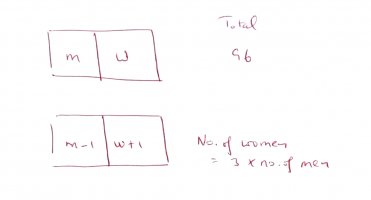I want to stress four things.
First, the issue of whether this
specific problem is ambiguous in not defining what is to be found is distinct from what is the best
generic method to introduce algebraic word problems to students.
Second, I wholeheartedly agree with harry that checking the answer against the original equations is essential. I have no disagreement there.
Third, I also agree that harry’s method of solving this specific problem is perfectly valid, is natural for anyone
already adept at algebra, and is what is typically taught. I am not objecting to the method itself. I am objecting to teaching it as an introduction to word problems.
Fourth, most students find learning algebra to be hard. Virtually everyone I have tutored in algebra, even those quite competent in the mechanics of algebra, struggle with “word problems.” But if you cannot do word problems, you cannot apply algebra to anything. We should be looking for methods to teach algebra, particularly word problems, that are as obvious to
beginning students as possible.
There are four unknown numbers. Harry lists four facts. Then Harry says that immediately gives us two equations in two unknowns. The student says “What? So you mean four quantitative facts and four unknowns immediately leads to two equations in two unknowns?” This of course is the wrong inference to make.
What is generally correct is that with n unknown numbers, we need at least n quantitative facts to find numerical values for the unknown numbers. Each of Harry’s listed facts leads to a simple equation. Two equations are so simple that those familiar with algebra can and will take a short cut and go immediately to two equations. But the short cut obscures the general process and will not work for more complicated problems. If a student is confused, using a short cut that apparently contradicts the general rule of “n unknowns require n equations” makes no sense.
Consider this analogy.
7x−34=4x+23⟹7x−34+34=4x+23+34⟹7x=4x+57⟹7x−4x=4x−4x+57⟹3x=57⟹33x=357⟹x=19.
That is how we teach beginning students how to solve an equation. Later of course we teach short cuts like
ax+b=cx+d⟹(a−c)x=d−b.
But we do not start there.
The traditional method of teaching students how to solve word problems makes no sense. It is not general. It requires doing algebra in your head. But it seems obvious to anyone who already knows algebra.
Here is a general method.
(1) Identify the potentially relevant quantities that are unknown.
(2) Assign a distinct letter to each of those unknown quantities.
(3) Identify, either through information in the problem itself or from information everyone is expected to know, at least as many quantitative facts about the relations among the unknown quantities as there are unknown quantities.
(4) Turn those facts into equations if possible.
(5) Apply algebra to those equations.
(6) Check your answers against the original equations.
For word problems that are soluble by algebra, this method works every time.
But,
in general, we do not teach this method consistently to beginning students before later showing them that some of the steps can sometimes be skipped. I view that general lack of consistency to be wrong pedagogically.
Now I must apologize. In context, it appears that I was calling Harry_the_Cat idiotic. That of course was not at all my intention. I admire her very much. In fact, I gave her first post in this thread a very prompt “like.”
Because I never was a professional teacher and only tutored before and then again after my years of employment, I never was taught how to teach algebra. I learned from one-on-one experience, mostly when I was only a few years older than my tutees. When teaching beginning algebra, I found that it helps a lot to forget much of what I knew about math and to remember how strange algebra seemed when I was twelve. What is obvious and thus simple to those of us comfortable with algebra and calculus is often far from obvious to a beginning student.
I think consistency is very important. Identify, label, and count every unknown. With n unknowns, look for n equations involving those unknowns.

